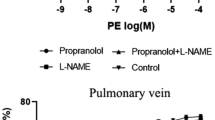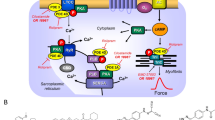Abstract
Objective
The principal effects of prostaglandin I2 are vasodilation and inhibition of platelet aggregation induced by a rise in the intracellular second messenger cAMP. In the heart a rise in intracellular myocardial cAMP increases contractility. We examined whether prostaglandin I2 increases left ventricular contractility in vivo. The effects of epoprostenol and iloprost on left ventricular contractility were assessed in vivo and compared to the effects of adenosine and sodium nitroprusside, which exerts vasodilatory properties independently of cAMP.
Design and setting
Prospective, randomized, cross-over in a university laboratory.
Subjects
Eleven pigs (25.9±2.8 kg, balanced anesthesia).
Interventions
Each animal was exposed to intravenous sodium nitroprusside, adenosine, and epoprostenol in randomized order. Iloprost was administered at the end due to its longer half-life. The dose was titrated to achieve a 25% reduction in diastolic aortic pressure.
Measurements and results
Left ventricular contractility was assessed before, during, and after each intervention by determination of the endsystolic elastance with the conductance method. While there was no change in endsystolic elastance upon the infusion of adenosine and sodium nitroprusside; endsystolic elastance increased in the case of epoprostenol (57%) and iloprost (71%) .
Conclusions
Left ventricular contractility is increased in vivo by epoprostenol and iloprost but not by adenosine or sodium nitroprusside at equipotent hypotensive dose. A contribution of sympathetic reflex activation of cardiac nerves on the increase in left ventricular contractility cannot be completely ruled out.



Similar content being viewed by others
References
Barst RJ, Rubin LJ, Long WA, McGoon MD, Rich S, Badesch DB, Groves BM, Tapson VF, Bourge RC, Brundage BH, Koerner SK, Langleben D, Keller CA, Murali S, Uretsky BF, Clayton LM, Jöbsis MM, Blackburn SD, Shortino D, Crow JW (1996) A comparison of continuous intravenous epoprostenol (prostacyclin) with conventional therapy for primary pulmonary hypertension. The Primary Pulmonary Hypertension Study Group. N Engl J Med 334:296–302
Kieler-Jensen N, Houltz E, Ricksten SE (1995) A comparison of prostacyclin and sodium nitroprusside for the treatment of heart failure after cardiac surgery. J Cardiothorac Vasc Anesth 9:641–646
Rich S, McLaughlin VV (1999) The effects of chronic prostacyclin therapy on cardiac output and symptoms in primary pulmonary hypertension. J Am Coll Cardiol 34:1184–1187
Pavlovic M, Petkovic D, Cvetkovic M, Macut DJ, Zdjelar K, Nesic M, Bosnic O, Radulovic R, Mihajlovic M (1995) The influence of prostacyclin (PGI2) on contractile properties of isolated right ventricle of rat heart. Experientia 51:941–944
Metsa KT (1981) Cyclic AMP-dependent and -independent effects of prostaglandins on the contraction-relaxation cycle of spontaneously beating isolated rat atria. Acta Physiol Scand 112:481–485
Fassina G, Tessari F, Dorigo P (1983) Positive inotropic effect of a stable analogue of PGI2 and of PGI2 on isolated guinea pig atria. Mechanism of action. Pharmacol Res Commun 15:735–749
Montalescot G, Drobinski G, Meurin P, Maclouf J, Sotirov I, Philippe F, Choussat R, Morin E, Thomas D (1998) Effects of prostacyclin on the pulmonary vascular tone and cardiac contractility of patients with pulmonary hypertension secondary to end-stage heart failure. Am J Cardiol 82:749–755
Suga H, Sagawa K, Shoukas AA (1973) Load independence of the instantaneous pressure-volume ratio of the canine left ventricle and effects of epinephrine and heart rate on the ratio. Circ Res 32:314–322
Baan J, van der Velde ET, de Bruin HG, Smeenk GJ, Koops J, van Dijk AD, Temmerman D, Senden J, Buis B (1984) Continuous measurement of left ventricular volume in animals and humans by conductance catheter. Circulation 70:812–823
Jacob R, Kissling G (1989) Ventricular pressure-volume relations as the primary basis for evaluation of cardiac mechanics. Return to Frank's diagram. Basic Res Cardiol 84:227–246
Sunagawa K, Maughan WL, Burkhoff D, Sagawa K (1983) Left ventricular interaction with arterial load studied in isolated canine ventricle. Am J Physiol 245:H773–H780
Kelly RP, Ting C-T, Yang T-M, Liu CP, Maughan WL, Chang M-S, Kass DA (1992) Effective arterial elastance as index of arterial vascular load in humans. Circulation 86:513–521
Hayashi K, Shigemi K, Shishido T, Sugimachi M, Sunagawa K (2000) Single-beat estimation of ventricular end-systolic elastance-effective arterial elastance as an index of ventricular mechanoenergetic performance. Anesthesiology 92:1769–1776
Takeuchi M, Odake M, Takaoka H, Hayashi Y, Yokoyama M (1992) Comparison between preload recruitable stroke work and the end-systolic pressure-volume relationship in man. Eur Heart J 13 [Suppl E]:80–84
Welte M, Goresch T, Frey L, Holzer K, Zwissler B, Messmer K (1995) Hypertonic saline dextran does not increase cardiac contractile function during small volume resuscitation from hemorrhagic shock in anesthetized pigs. Anesth Analg 80:1099–1107
Fleetwood G, Bettmann MA, Gordon JL (1990) The effects of radiographic contrast media on myocardial contractility and coronary resistance: osmolality, ionic concentration, and viscosity. Invest Radiol 25:254–260
Hohlfeld T, Zucker TP, Meyer J, Schror K (1997) Expression, function, and regulation of E-type prostaglandin receptors (EP3) in the nonischemic and ischemic pig heart. Circ Res 81:765–773
Pavlovic M, Petkovic D, Cvetkovic M, Zdjelar K, Starcevic V, Bosnic O (1992) Study of the mechanism of prostacyclin (PgI2) action on myocardial contractility. Agents Actions Suppl 37:171–175
Finkel MS, Oddis CV, Jacob TD, Watkins SC, Hattler BG, Simmons RL (1992) Negative inotropic effects of cytokines on the heart mediated by nitric oxide. Science 257:387–389
Mohan P, Brutsaert DL, Paulus WJ, Sys SU (1996) Myocardial contractile response to nitric oxide and cGMP. Circulation 93:1223–1229
Liang BT (1989) Characterization of the adenosine receptor in cultured embryonic chick atrial myocytes: coupling to modulation of contractility and adenylate cyclase activity and identification by direct radioligand binding. J Pharmacol Exp Ther 249:775–784
Sawmiller DR, Fenton RA, Dobson JGJ (1996) Myocardial adenosine A1 and A2 receptor activities during juvenile and adult stages of development. Am J Physiol 271:H235–H243
Ujhelyi MR, Hulula G, Skau KA (1994) Role of exogenous adenosine as a modulator of theophylline toxicity. Crit Care Med 22:1639–1646
Romano FD, Naimi TS, Dobson-JG J (1991) Adenosine attenuation of catecholamine-enhanced contractility of rat heart in vivo. Am J Physiol 260:H1635–H1639
Welte M, Zwissler B, Frey L, Goresch T, Kleen M, Holzer K, Messmer K (1996) Hypovolemic shock and cardiac contractility: assessment by end-systolic pressure-volume relations. Res Exp Med 196:87–104
Velde ET van der, Burkhoff D, Steendijk P, Karsdon J, Sagawa K, Baan J (1991) Nonlinearity and load sensitivity of end-systolic pressure-volume relation of canine left ventricle in vivo. Circulation 83:315–327
Kass DA, Beyar R, Lankford E, Heard M, Maughan WL, Sagawa K (1989) Influence of contractile state on curvilinearity of in situ end-systolic pressure-volume relations. Circulation 79:167–178
Burkhoff D, Sugiura S, Yue DT, Sagawa K (1987) Contractility-dependent curvilinearity of end-systolic pressure-volume relations. Am J Physiol 252:H1218–H1227
Velde ET van der, Burkhoff D, Steendijk P, Karsdon J, Sagawa K, Baan J (1991) Nonlinearity and load sensitivity of end-systolic pressure-volume relation of canine left ventricle in vivo. Circulation 83:315–327
Kass DA, Maughan WL (1988) From 'Emax' to pressure-volume relations: a broader view. Circulation 77:1203–1212
Spratt JA, Tyson GS, Glower DD, Davis JW, Muhlbaier LH, Olsen CO, Rankin JS (1987) The end-systolic pressure volume relationship in conscious dogs. Circulation 75:1295–1309
Acknowledgements
The excellent advice and research terms as provided by Prof. Dr. med. Dr. h.c. mult. Konrad Meßmer are greatly acknowledged. We thank Alke Schropp for valuable contributions on sample processing, Brigitte Blount (nationally certificated keeper) and her team for professional animal care. To Dr. Maag, Institute for Medical Information Processing, Biometry and Epidemiology, and Dr. Peters, Institute for Surgical Research, we are highly indebted for designing the statistical procedure. The work was performed at the Institute for Surgical Research, Ludwig Maximilian University, Klinikum Großhadern Munich, Germany.
Author information
Authors and Affiliations
Corresponding author
Additional information
The study was supported by a research grant (Reg-No. 79 FöFoLe), Medical Faculty of the Ludwig Maximilian University of Munich.
An editorial regarding this article can be found in the same issue (http://dx.doi.org/10.1007/s00134-003-1834-8)
Rights and permissions
About this article
Cite this article
Kisch-Wedel, H., Kemming, G., Meisner, F. et al. The prostaglandins epoprostenol and iloprost increase left ventricular contractility in vivo. Intensive Care Med 29, 1574–1583 (2003). https://doi.org/10.1007/s00134-003-1891-z
Received:
Accepted:
Published:
Issue Date:
DOI: https://doi.org/10.1007/s00134-003-1891-z




